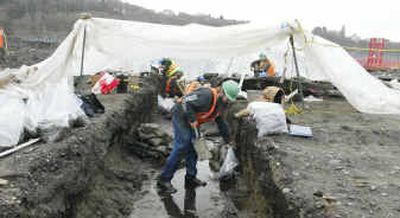Discovery may force state to move bridge

PORT ANGELES, Wash. – The remains of hundreds of ancient Indians unearthed at a large bridge construction site have state officials ready to cut their losses – millions of dollars and months of delays – and find another site.
“It is true we’ve spent money we won’t get back, but we also have found a major historical site that’s important to understanding the culture of the Pacific Northwest coast,” state Transportation Secretary Doug MacDonald said Friday.
The state has already spent $55 million on a project initially slated to cost $283 million.
State officials have all but decided to abandon the waterfront site they planned to use to build new pontoons and anchors for the aging Hood Canal floating bridge. But MacDonald said before an official decision is made the agency must clarify future plans for the site with the Lower Elwah Klallam Tribe, the city of Port Angeles, and federal and state leaders.
He would not give specific details, but said talks would include what will happen to the site and how it will be used.
“We don’t just want to be in a position of lurching forward. We have to be able to give people a sense of what’s going to happen,” MacDonald said.
The 22.5-acre site on Olympic Peninsula was the favored spot for the state’s dry dock because other sites were too small or presented permit and hazardous waste issues. But on Aug. 20, 2003, the first human bone fragment was found, and work stopped six days later.
The site is where the Klallam village of Tse-whit-zen stood for 1,700 years before it was leveled in the 1920s to make way for a sawmill.
Both the state and the tribe were aware of the former village, and the department hired Western Shores Heritage Services to survey the site for archaeological remains.
Limited by concrete slabs and buildings, Western Shores concluded there was no evidence of significant ancient remains within the boundaries of the proposed project site. The tribe’s analysis of an 1853 U.S. Coast Survey map also showed the village was south and east of the planned dry dock.
No one was anticipated the hundreds of full or partial remains that have been found. The discoveries continued this week at the waterfront site where archeologists painstakingly brushed away heavy, compacted dirt to reveal what may be a grass mat, or perhaps remnants of a ceremonial costume.
Each find is bittersweet for the Klallam, whose tribal chairwoman, Frances G. Charles, sent a letter last week to MacDonald demanding a halt to all excavation.
“I was angry. I was hurt. How could another human being treat another human being that way?” Charles said, tears welling in her eyes as she struggled to describe how she felt upon seeing her elders’ crushed skulls and human remains resting atop metal and concrete water pipes.
Thursday, tribal members moved another 18 cedar boxes filled with remains of their ancestors to a nearby storage building.
So far, they have filled 278 makeshift coffins made of cedar planks and wooden pegs. They’re at most three feet long, although those carrying infant remains are much smaller, and some contain the remains of as many as 11 people.
The coffins and the 800 isolated skeletal parts and other artifacts discovered is a collection that the tribe and state archaeologists have said is the largest archaeological find in the region.